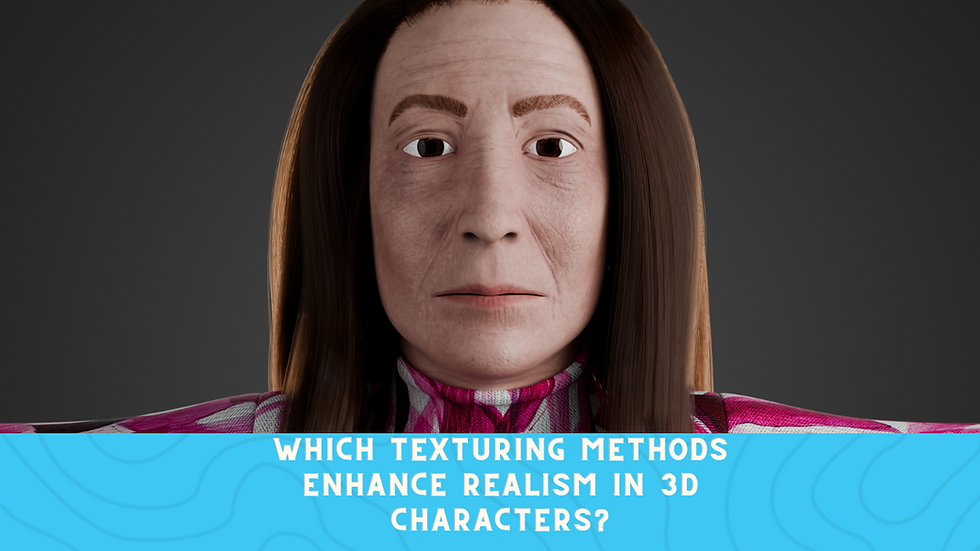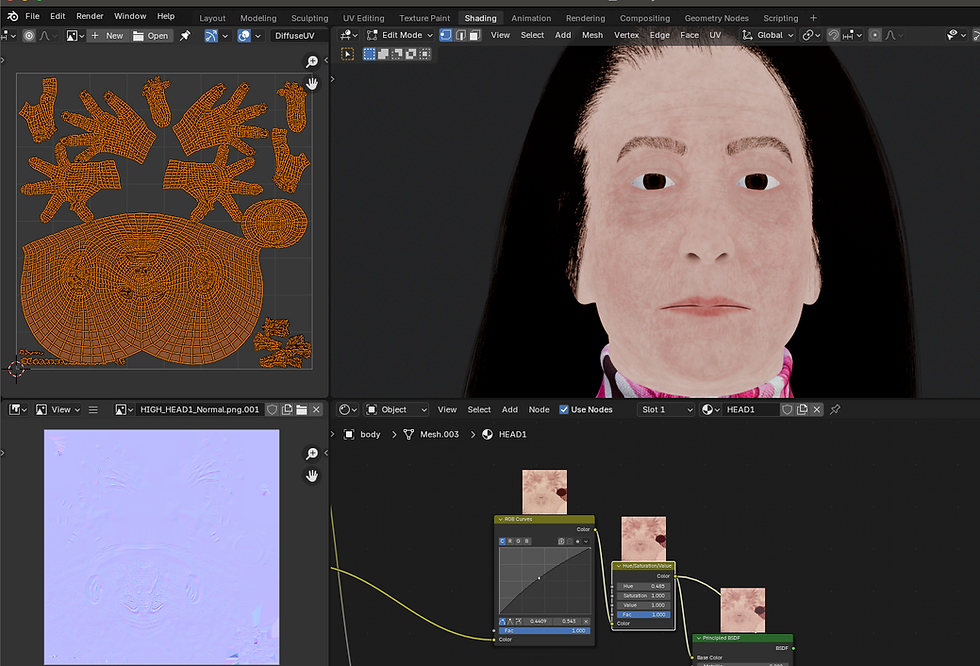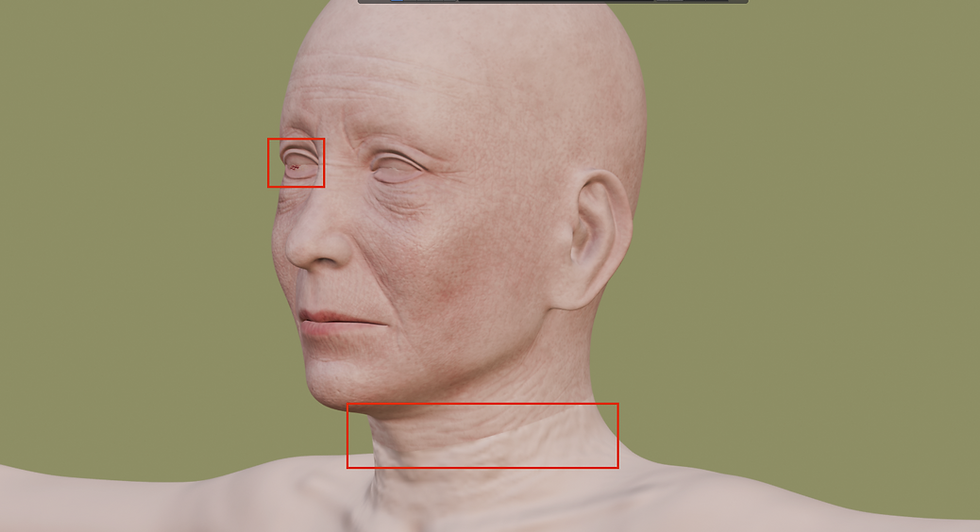
When it comes to crafting lifelike 3D Characters, the magic lies in the details, and texturing methods are at the heart of this transformation. Texturing is the bridge between a simple 3D model and a visually captivating character that tells a story. It brings out the depth, emotion, and authenticity of your design, making it feel as close to reality as possible. Whether you're working on characters for video games, animated films, or augmented reality applications, the role of realism in 3D characters cannot be overstated.
QUICK LINKS :
So, what makes texturing so crucial? Imagine a beautifully modeled character lacking the subtle play of light on skin, the intricate fabric patterns on clothing, or the gleaming surface of armor. Without proper textures, even the most intricately modeled character can fall flat. This is why mastering essential character texturing techniques like UV Mapping, Normal Mapping, and Displacement Mapping is key to achieving a polished and professional look.
At Whizzy Studios, we specialize in taking your designs to the next level with advanced 3D Character Design processes. Our team understands that textures are more than just skin deep—they define the feel and mood of a character. By leveraging modern techniques like Photorealistic Texturing, Procedural Texturing, and Physically Based Rendering (PBR), we ensure that every detail is as vivid as it can be. Need a specialist to help you with your project? Consider partnering with us to Hire Dedicated 3D Character Designer for bespoke solutions.
In this blog, we’ll explore how techniques such as Diffuse Texturing, Ambient Occlusion, and Texture Baking work together to enhance realism in 3D characters. You’ll also discover the value of creative approaches like Hand-Painted Texturing for stylized projects or Photogrammetry for ultra-realistic designs. Each method we discuss is designed to elevate your work and inspire you to try new approaches.
Whether you’re a budding 3D artist or a seasoned designer, this guide will provide practical insights and actionable tips to improve your 3D Texture Optimization workflow. Let’s dive into the world of textures and unlock the potential they hold for bringing your 3D Characters to life.
Key Texturing Methods

To achieve stunning realism in 3D characters, a variety of texturing methods can be applied. Each method serves a unique purpose in enhancing the visual appeal of your designs. Let’s explore some of the most impactful techniques:
UV Mapping
UV Mapping is the foundation of all character texturing techniques. It involves unwrapping a 3D model into a 2D plane, enabling textures to be applied accurately without distortion. This process ensures every part of the model is textured with precision, from intricate facial features to complex clothing patterns. At Whizzy Studios, our experts in 3D Character Design emphasize seamless UV layouts to enhance 3D Texture Optimization.
Diffuse Texturing
Diffuse Texturing adds base colors and patterns to a model, defining its overall look. It’s the first step in giving life to your 3D Characters, creating the primary visual impact. Combined with other techniques like Normal Mapping and Ambient Occlusion, it ensures cohesive and realistic results.
Specular and Glossiness Mapping
Specular and Glossiness Mapping control the shininess and reflectivity of a model’s surface. Whether it’s the gleam of polished armor or the subtle shine of glass, this method simulates material properties, adding depth to the design.
Normal Mapping
For intricate surface details without increasing polygon count, Normal Mapping is the go-to technique. It creates the illusion of depth and texture by altering how light interacts with the surface. At Whizzy Studios, we use this extensively in our 3D Character Design projects.
Bump Mapping
Bump Mapping is similar to Normal Mapping but focuses on small surface irregularities, like scratches or dents. It’s an efficient way to add subtle texture variations that enhance realism in 3D characters.
Displacement Mapping
Unlike Bump Mapping, Displacement Mapping alters the geometry of a model, creating dramatic surface features like wrinkles or folds. This method is perfect for high-detail characters requiring close-up visuals.
Ambient Occlusion Mapping
Ambient Occlusion Mapping simulates shadows in crevices and folds, adding depth and realism to models. This subtle shading effect creates a more lifelike appearance by mimicking how light interacts in the real world.
Photorealistic Texturing
Photorealistic Texturing involves using high-resolution photographs to create lifelike textures. It’s ideal for projects that demand high fidelity and realism in 3D characters.
Hand-Painted Texturing
For stylized or unique character designs, Hand-Painted Texturing offers unparalleled customization. This technique involves manually painting textures, giving models a distinctive and artistic flair.
Procedural Texturing
Procedural Texturing generates complex patterns and materials algorithmically. It’s efficient for creating intricate designs like wood grain or marble textures without manual effort.
Physically Based Rendering (PBR) Texturing
PBR Texturing ensures materials react to light realistically. Widely used in modern games and films, it combines Diffuse, Specular, and Normal Mapping for dynamic visuals. At Whizzy Studios, we integrate PBR workflows in our 3D Character Design.
Decals
Decals are small details, such as stickers, logos, or dirt, applied to models without altering their primary textures. This method is excellent for adding finishing touches that enhance character depth.
Photogrammetry
Photogrammetry uses photographs of real-world objects to generate detailed textures. It’s a powerful tool for achieving ultra-realistic results in 3D Characters.
Sculpting
Sculpting involves directly shaping a model’s surface to create fine details like wrinkles or scars. This process ensures precision and artistic control over a character’s appearance.
Texture Baking
Texture Baking transfers details from high-resolution models to low-resolution ones, maintaining visual fidelity while optimizing performance. This technique is crucial for projects where efficiency is key.
Enhancing Realism Through Texturing

Achieving realism in 3D characters requires more than just individual texturing methods—it’s about combining techniques to create cohesive and visually stunning results. By layering and blending methods like UV Mapping, Normal Mapping, and Physically Based Rendering (PBR), you can elevate your designs to a professional level. Let’s explore how these combinations work and their impact in real-world projects.
Combining Methods for Optimal Results
A single texturing method might provide a solid foundation, but true 3D Character Design thrives on synergy. For example, UV Mapping lays the groundwork for precise texturing, while Diffuse Texturing adds the base colors. Incorporating Ambient Occlusion introduces realistic shadows, and Specular Mapping highlights reflective properties.
At Whizzy Studios, we take this multi-method approach seriously. For our clients, we integrate advanced techniques like Texture Baking and Procedural Texturing to optimize workflows without compromising detail. If you’re looking for expertise, consider working with our specialists to Hire Dedicated 3D Character Designer, ensuring every detail aligns perfectly.
Examples of Effective Usage in Games and Films
The impact of combining texturing methods is evident in top-tier video games and films. In gaming, titles like The Last of Us use a mix of Photorealistic Texturing and Normal Mapping to create lifelike environments and characters. Similarly, Physically Based Rendering (PBR) ensures dynamic interaction with lighting, making every scene immersive.
In animated films like Frozen, Hand-Painted Texturing brings characters to life with stylized charm, while Displacement Mapping adds depth to snow-covered landscapes. By strategically blending methods, these projects achieve both artistic and technical excellence.
At Whizzy Studios, our 3D Character Design team has applied these principles to countless projects. From games to animated series, we’ve mastered the art of merging techniques like Photogrammetry, Decals, and Sculpting for unparalleled results.
Making Textures Work for You
When combining techniques, it’s essential to consider the character’s purpose and the platform it’s designed for. High-detail textures with Ambient Occlusion and Bump Mapping might suit films, while optimized Texture Baking ensures smooth performance in games. The key is to balance creativity with technical requirements—a skill that our team at Whizzy Studios excels in.
By mastering the interplay of texturing methods, you can ensure your 3D Characters resonate with audiences, whether they’re on-screen or in virtual reality. With the right guidance and tools, the possibilities are endless.
Common Challenges in Texturing

Even the most advanced texturing methods can encounter challenges during 3D Character Design. From issues like texture stretching and seams to balancing performance with realism in 3D characters, addressing these problems requires both skill and strategy. Let’s delve into these challenges and explore effective solutions.
Addressing Issues Like Stretching and Seams
One of the most common hurdles in UV Mapping is texture stretching, where the texture appears distorted on certain parts of the model. This can break the immersion and ruin the realism in 3D characters. Proper UV Mapping practices, such as minimizing stretching in critical areas and ensuring uniform scaling, are essential.
Another issue is visible seams where the edges of textures meet. Techniques like Ambient Occlusion Mapping and careful use of Diffuse Texturing can help blend these seams seamlessly. At Whizzy Studios, our team uses advanced tools to eliminate such problems, ensuring a polished look for all our 3D Character Design projects.
Optimizing Textures for Performance and Realism
Balancing high-quality textures with performance requirements is a constant challenge, especially in gaming. Techniques like Texture Baking can significantly reduce resource usage while maintaining visual fidelity. By transferring details from high-resolution models to lower-resolution ones, Texture Baking ensures your 3D Characters look realistic without sacrificing performance.
Procedural Texturing is another powerful tool for optimizing workflows. It generates textures algorithmically, allowing for infinite detail with minimal memory usage. Similarly, Photorealistic Texturing combined with Physically Based Rendering (PBR) ensures materials react dynamically to light, enhancing realism while remaining efficient.
At Whizzy Studios, we also emphasize the importance of 3D Texture Optimization. By employing techniques like Normal Mapping, Specular Mapping, and Displacement Mapping, we create visually rich characters that perform seamlessly across platforms. If you’re tackling texture optimization challenges, consider working with us to Hire Dedicated 3D Character Designer who can help streamline your workflow.
Bridging the Gap Between Creativity and Technicality
Texturing is as much about artistry as it is about technical skill. For example, Hand-Painted Texturing can add unique artistic elements, but it must be carefully balanced with UV Mapping to avoid stretching or pixelation. Similarly, combining Photogrammetry with Sculpting can create intricate details, but requires expertise to optimize for real-time applications.
At Whizzy Studios, we understand these nuances. Our 3D Character Design process focuses on merging creativity with technical precision, ensuring that your 3D Characters not only look stunning but also perform flawlessly.
Conclusion
Texturing is a cornerstone of 3D Character Design, transforming basic models into lifelike and engaging creations. By mastering various texturing methods, such as UV Mapping, Diffuse Texturing, and Ambient Occlusion Mapping, you can achieve unparalleled realism in 3D characters. Advanced techniques like Normal Mapping, Physically Based Rendering (PBR), and Photorealistic Texturing allow designers to add intricate details while maintaining performance.
The journey doesn’t end with mastering the basics. Combining methods like Texture Baking, Procedural Texturing, and Displacement Mapping can open up new creative possibilities. At Whizzy Studios, we specialize in integrating these methods into projects that captivate and inspire. Whether it’s creating stylized characters with Hand-Painted Texturing or using Photogrammetry to achieve hyper-realistic results, the possibilities are limitless.
For those looking to elevate their designs, exploring these advanced techniques can significantly enhance your work. If you’re ready to bring your vision to life, consider partnering with us to Hire Dedicated 3D Character Designer. Our team ensures every project reflects the perfect balance of creativity and technical precision.
Remember, every detail matters in 3D Character Design. From tackling challenges like texture stretching and seams to optimizing 3D Texture Optimization, your commitment to refining these skills will set your work apart. So, dive into the world of texturing methods, experiment, and let your creativity shine.

Comments